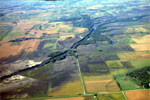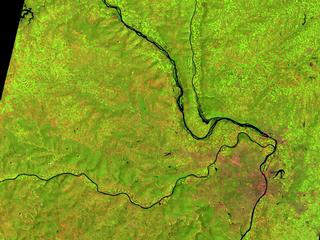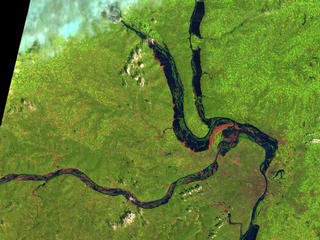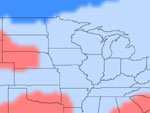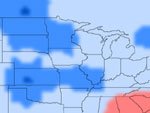October 28, 2002 - (date of web publication)
Computer Model Suggests Future Crop Loss Due to Potential Increase in Extreme Rain Events Over Next Century
-----------------
Image 1
Caption for Image 1: Iowa River after 1993 Midwest Flood
Aerial view of the Iowa River in eastern Iowa after floodwaters had receded (Sept. 1993). The sediment deposition clearly denotes the maximum extent of floodwater inundation. Note the amount of water left behind in the low-lying areas.
Along with direct damage from floods, which are extreme events with localized effects, crop damage from excess soil moisture associated with heavy rainfall tends to be longer lasting and wider spread. Too much water in the soil drowns roots and prevents them from growing, increases the risk of plant diseases and insect infestation, and can delay planting and harvesting by making it hard to operate machinery on wet land. Credit: USGS
Click here for the high resolution version of Image 1
-----------------
An increased frequency of extreme precipitation events has been observed over the last 100 years in the United States. Global climate models project that similar trends may continue and even strengthen over the coming decades, due to climate change. Now, a study using computer climate and crop model simulations predicts that U.S. agricultural production losses due to excess rainfall may double in the next 30 years, resulting in an estimated $3 billion per year in damages.
Cynthia Rosenzweig and Francesco Tubiello, researchers at the NASA Goddard Institute for Space Studies and Columbia University, New York, and the other authors of this study, found that current assessments of the impacts of climate change on agriculture have not accounted for the negative impacts on crops from increased precipitation and floods. In an effort to close this information gap, the researchers modified an existing crop computer model to simulate the extent to which excess soil moisture from heavy rain might damage crop plants.
"The impacts of excess soil moisture due to increased precipitation need to be taken into account because of associated crop losses and potential financial damages," Rosenzweig said.
The researchers argue that while droughts receive the most attention when it comes to assessing the impacts of climate change on agriculture, excess precipitation should also be a major concern. The 1993 U.S. Midwest floods, for example, caused about $6 to 8 billion in damages to farmers, accounting for roughly half of the total overall losses from the flood, according to the Federal Emergency Management Agency. Overall precipitation and extreme rain events are projected to increase in the future because of stronger water cycle dynamics associated with global warming.
-----------------
Image 2
Caption for Image 2: Missouri River Before Flood
This image shows the junction of the Mississippi, Illinois, and Missouri Rivers in August 1991 (two years before the floods). Credit: NASA/Goddard Space Flight Center Scientific Visualization Studio
Click here for the high resolution version of Image 2
-----------------
-----------------
Image 3
Caption for Image 3: Missouri River After the Flood
This image shows the junction of the Mississippi, Illinois, and Missouri Rivers in August 1993 (near peak of the flooding). Credit: NASA/Goddard Space Flight Center Scientific Visualization Studio
Click here for the high resolution version of Image 3
Click here for an animation of a side-by-side comparison of the river before and after the flooding. (4.47 MB)
-----------------
Global climate model simulations used in the study project increases in total precipitation and in the number of extreme precipitation events in the Corn Belt and on average for the continental United States. Over the Corn Belt states, the average number of extreme precipitation events was 30 percent above present levels in the 2030s, and 65 percent higher in the 2090s. The same climate projections were used for a 2001 U.S. national assessment report on potential consequences of climate change.
The researchers also modified an existing crop model, called CERES-Maize, in order to simulate the effects of excess soil moisture from heavy precipitation on corn crops. The model calculates plant development, growth and final yield based on weather, crop genetic traits and management practices. The researchers modified CERES-Maize by adding in a function that limited the simulated plant's ability to grow roots after three consecutive days of soil saturation. The model simulated corn growth in nine U.S. Corn Belt states, including Kansas, Nebraska, Illinois, Indiana, Iowa, North and South Dakota, Ohio and Wisconsin, which represent 85 percent of total U.S. corn production.
-----------------
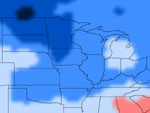
|
||
| Year 2020 | Year 2050 | Year 2080 |
Caption for Images 4-6: Global Climate Model Projections
These images show projections of rainfall changes from a NASA global climate model for the 2020s, 2050s and 2080s. The model includes influences from medium population and related green house gas emissions growth rate. Credit: NASA/Goddard Space Flight Center Scientific Visualization Studio
-----------------
The modified model showed that the probability of crop damage due to water-logged soils could be even greater than the projected increases in heavy precipitation - corresponding to 90 percent more damage in the 2030s, and 150 percent more damage by the 2090s, compared to present conditions.
To relate the climate and crop model results to economic losses, Rosenzweig and her colleagues used USDA economic data to estimate that damages to U.S. corn production due to excess soil moisture currently amount to about $600 million per year.
The researchers then estimated that potential future damages to major U.S. crops due to excess soil moisture could lead to total losses of up to $3 billion per year by the 2030s, on average.
The study appears in the current issue of Global Environmental Change. The research was conducted at the Climate Impacts Group of the NASA Goddard Institute for Space Studies at the Earth Institute at Columbia University and was supported by Environmental Defense and the Environmental Protection Agency.
For more information contact:
Krishna Ramanujan
Goddard Space Flight Center
Greenbelt, MD 20771
(Phone: 301/286-3026)
Rani Chohan
Goddard Space Flight Center
Greenbelt, MD 20771
(Phone: 301/286-2483)
Mariellen Gallagher
Earth Institute at Columbia University
(Phone: 845-365-8565)
Allen Margolin
Environmental Defense
(Phone: 212-505-2100)
Environmental Protection Agency
United States Department of Agriculture
Federal Emergency Management Agency
